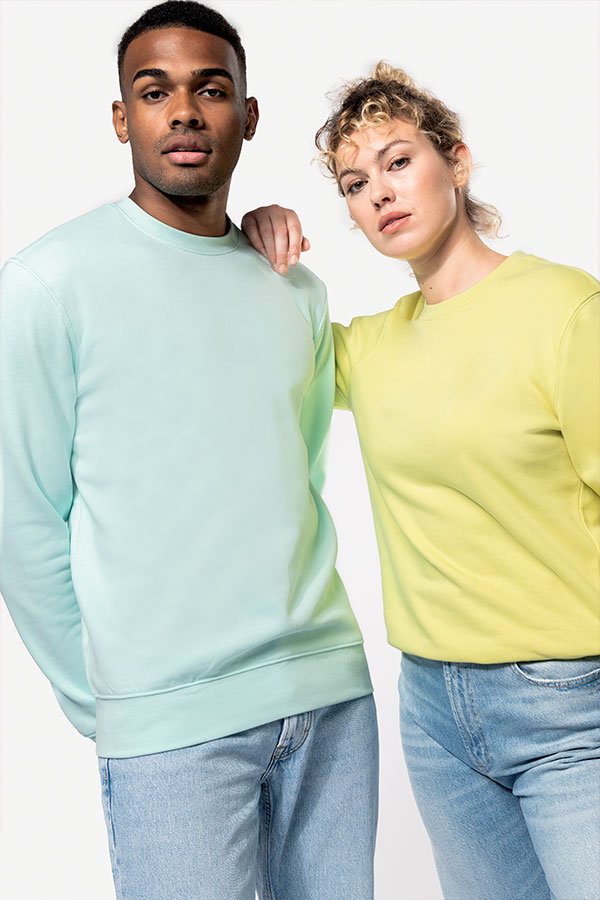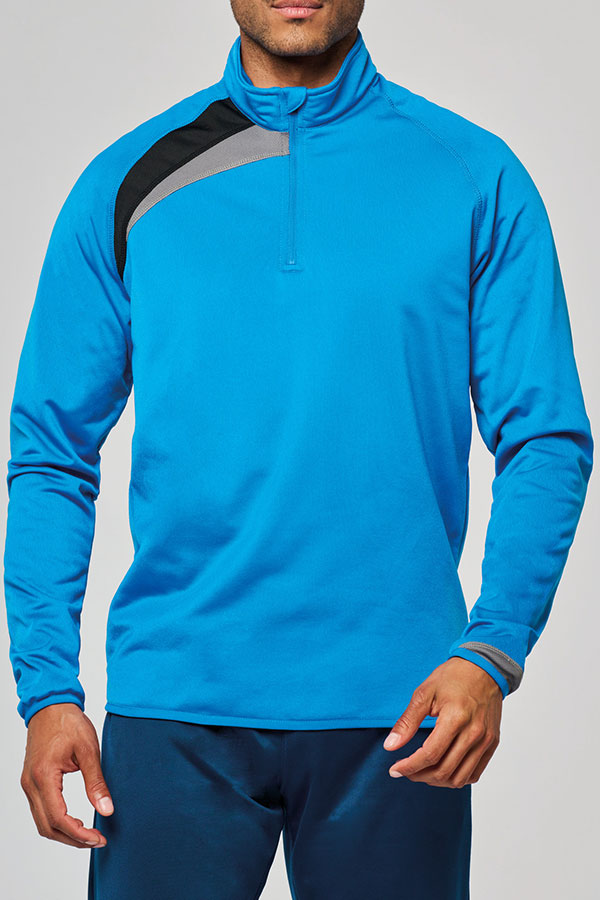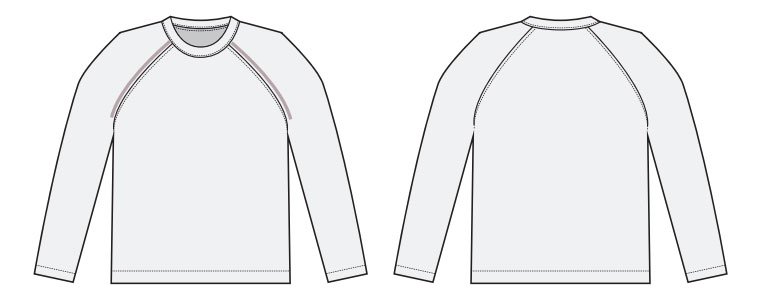A timeless basic with a unisex cut that suits a wide range of body shapes, the sweatshirt has become a must-have in all wardrobes!
Did you know that it was invented in the 1920s as a replacement for athletes’ pullovers? Too rough, thick and warm, the wool pullover caused excess sweating, making it very uncomfortable during high-intensity activity.
This observation made history: the student and footballer Benny Russel had the idea of making a “jumper to sweat in”, hence the term “sweatshirt”.
Cotton replaced wool in this brand-new collarless, lightweight pullover. The end result was much softer and more comfortable to wear than its predecessor, as well as allowing greater freedom of movement.
The sweatshirt soon became popular among stars and athletes, which played a major role in its mainstream appeal. The customised version then emerged, making it an undeniable asset for sending a message or displaying allegiance to a group.
The sweatshirt is as popular as ever and available in various cuts and material and colour combinations. A dream for athletes, professionals and fans of casual attire!
You now know the history of the sweatshirt so let’s find out how to choose one. From the material, to the cut and the types of knit, we take a closer look at this iconic piece!
Why choose a customisable sweatshirt?
When we think of a sweatshirt, we think of a comfortable, extremely versatile and laid-back piece. Various benefits make it a great choice:
- a unisex cut and a timeless look suitable for numerous occasions
- thick fabric, a tight knit and a smooth appearance suitable for all marking techniques and a particularly high-quality finish (a sweatshirt can be embroidered, printed, silkscreen-printed, etc.)
- a comfortable shape with a varying degree of stretch depending on the material
- an easy to slip on piece with a crew neck that is often ribbed and stretchy enough to easily go over the head
It has been widely adopted by ready-to-wear brands, companies and associations! A few perfect occasions for a sweatshirt:
- A flocked sweatshirt with a company logo can be gifted to its teams
- It can round off the basics collection in a casual or streetwear fashion store
- It can be worn by participants in an association or sporting event
- It is commonly worn by students in the colours of their school or university
The TopTex selection
Crew neck sweatshirt

K443
Unisex hooded sweatshirt
Hooded sweatshirt

K476
Men’s hooded sweatshirt
Zipped hooded sweatshirt

K466
Contrast hooded full zip sweatshirt
How to choose the most suitable material
100% cotton
To make it absorbent and insulating, the original sweatshirt was made of cotton. And this is often the case! This natural fibre is known for being soft and comfortable so it’s only natural that it’s used on many sweatshirt models.
Cotton sweatshirts for:
- the members of a student office looking to organise an event
- the teams in a trendy store, seeking a comfortable and modern sportswear look
- the artisan and services industries looking for good flexibility and maximum comfort
TopTex’s selection of 100% cotton sweatshirts

KV2315
Men’s French Terry hooded sweatshirt

K495
Organic piqué sweatshirt

WK402
Men’s crew neck sweatshirt
Polycotton
Cotton is the perfect blend of other synthetic fibres to give additional properties to sweatshirts. Sweatshirts are made with viscose for a silky finish and an attractive drape. However, cotton is often combined with polyester, resulting in a more stretchy and resistant material that does not pill. This is known as polycotton. The blend of white cotton fibres and black polyester fibres creates the famous marled fabric (or “heather” as it is called by textile professionals) – a must-have colour!
Polycotton sweatshirts for:
- a company looking to give flocked sweatshirts to its teams
- delivery drivers who need a cosy and slightly more water repellent garment that dries faster than 100% cotton in the event of light rain
TopTex’s selection of polycotton sweatshirts

K474
Unisex crew neck sweatshirt

K465
Ladies’ contrast hooded sweatshirt

K472
Men's full zip fleece jacket
100% synthetic fibres
Finally, several models in synthetic fibres are available. Materials with very specific characteristics, particularly useful in certain situations. For example, polyamide combined with a polyurethane coating will create a water repellent and tear resistant fabric.
A sweatshirt in synthetic fibres for:
- runners seeking a lightweight, easy-care garment
- club athletes who need an ultra-resistant training sweatshirt
TopTex’s selection of 100% synthetic sweatshirts
Sport sweatshirt

PA328
Adults' zip neck training top
Rain sweatshirt

PA330
Adults' rain sweatshirt
Polyester–elastane sweatshirt

PA360
Unisex zip neck hooded sports sweatshirt
Which knit creates which finish on a sweatshirt?
Sweatshirts are unique in that they are crafted from a knit and not a weave: this creates a thick, supple and comfortable fabric.
Some pieces are even made with Air Jet yarn to achieve a particularly smooth surface which does not pill, perfect for customisation with printing or silkscreen printing, for example.
A sweatshirt may be made from cotton, polycotton or polyester with two or three yarns for varied thicknesses and finishes:

Brushed fleece
Soft and fluffy, brushed fleece may contain three layers:
- the outer layer in combed cotton for a very smooth surface
- the intermediate layer in polyester for good resistance and fabric elasticity
- the inner layer in brushed polycotton for that lovely fluffy effect in cold weather

The French Terry knit
Also known as Jersey terry, it differs from the previous type of knit in that the inner layer is not brushed: therefore it lacks that fluffy appearance. On the other hand, a French Terry sweatshirt is thinner and more breathable. Perfect for mid-season!

Interlock knit
A double thickness, compact knit: the secret of a hard-wearing and silky fabric.
The various weights
Weight is expressed in number of grams per m². In other words, it determines the thickness of a fabric. You can choose between different weights depending on the season, use, finish and level of comfort desired. For a warm and soft sweatshirt with an embroidered logo, opt for a brushed fleece model with a weight of 300 g/m² or higher. For a slightly more lightweight model silkscreen printed with a university logo, choose a weight of 280 g/m² or less.
The TopTex selection
Brushed fleece sweatshirt

K443
Unisex hooded sweatshirt
French Terry sweatshirt

K4008
Unisex eco-friendly French Terry zipped hooded sweatshirt
Interlock knit sweatshirt

PK404
Men's zipped jacket
Low Shrinkage: what is it?
For truly hard-wearing sweatshirts, there is a specific treatment which reduces the risk of the garment shrinking or losing its shape. This is the Low Shrinkage treatment.
This process consists of pre-shrinking the fabric before assembling the garment, using two machines:
- a compactor which injects water vapour into the fabric to stabilise the shrinkage,
- a stenter which heats and dries the fabric to complete and stabilise the previous treatment and produce a soft and smooth fabric that does not pill.
This process can be applied to the various knits set out above:
- LSF = Low Shrinkage Fleece for a brushed sweatshirt
- LST = Low Shrinkage Terry for a non-brushed sweatshirt
- LSI = Low Shrinkage Interlock for the knit of the same name
The TopTex selection
LSF treatment

K4032
Unisex oversized eco-friendly crew neck sweatshirt
LST treatment

K4009
Unisex eco-friendly zipped French Terry hoodie
LSI treatment

PK400
Men's zipped hoodie
Cut, look and care: finalise your choice!
Sweatshirt shapes
You’ve reflected on the material, thickness, knit and the desired finish. So it’s time to consider the shape and cut! Here are the three most well-known and most popular main sweatshirt shapes:
The TopTex selection
Zipped hooded sweatshirt

KV2306
Men’s vintage zipped hooded sweatshirt
Hooded sweatshirt (or Hoodie)

K446
Men's contrast hooded sweatshirt
Classic crew neck sweatshirt

K480
Men's organic cotton crew neck raglan sleeve sweatshirt
Want to customise a zipped sweatshirt? Then consider a model with a covered zip, allowing you to print all of the front fabric without being obstructed by the zip fastening. However, there are also zipped neck models which free up most of the front for a logo!
The finishes
This allows a host of details:
- with or without a front pocket (or kangaroo pocket)
- crew neck with the sweatshirt’s iconic triangle or a funnel neck
- a drawstring with reinforced metal tips
- unisex sizes and cuts, from slimmer to very loose fits
- plain or two-tone colourways available
There are also two different sleeves to choose from:
Raglan sleeves

Raglan sleeves are sewn diagonally, from the armpits to the neck. This cut is easy to slip on, more comfortable and reduces areas of friction.
Perfect for a sports sweatshirt or for professionals who need good freedom of movement.
Les manches montées

Set-in sleeves are more classic and sewn from the underarms to the shoulder.
With this shape, you must choose the right size to ensure a comfortable fit.
Finally, if the eco-friendly dimension is important to your customer, consider sustainable alternatives, such as organic cotton or recycled polyester!
TopTex’s selection of eco-friendly sweatshirts

K491
Men's two-tone organic crew neck raglan sleeve sweatshirt

K4027
Men's eco-friendly hooded sweatshirt

K4030
Men's eco-friendly zip-through hoodie
Care
A sweatshirt should always be washed on the reverse and this is even truer for a customised sweatshirt. Temperature wise, a classic wash at 30° will prevent any damage but the instructions will always be indicated on each product’s care label.
It is recommended that you avoid the tumble dryer which may harm the elasticity of fibres and ribbing, especially at the cuffs and neck. A sweatshirt should not be stretched out on a hanger either: once wet, the fabric becomes heavy and may deform the hanging garment. It is better to dry a sweatshirt flat or on a classic clotheshorse.
You now have everything you need to choose the best customisable sweatshirt depending on your customer’s needs. To summarise, here are a few key points on the main materials, models and cuts set out in this article:
Material
|
COTTON
|
absorbent, insulating and soft |
|
POLYESTER
|
lightweight and easy care |
|
POLYCOTTON
|
stretchy and resistant |
Model
|
HOODIE
|
with hood and front pocket |
|
ZIPPED
|
quick and easy to put on and take off |
|
CLASSIC
|
basic with a timeless crew neck |
Relaxed
|
FIT
|
comfortable for good freedom of movement |
|
FITTED
|
a closer fit for a casual look |
|
LOOSE
|
wide and comfortable to wear |
Do you have any questions or need help to make your decision? Our advisers are available and will be pleased to assist you.
P.S.: some sweatshirt models on our website are “No label“, or come with a detachable label, allowing your customers to add their own brand. Think about it!






